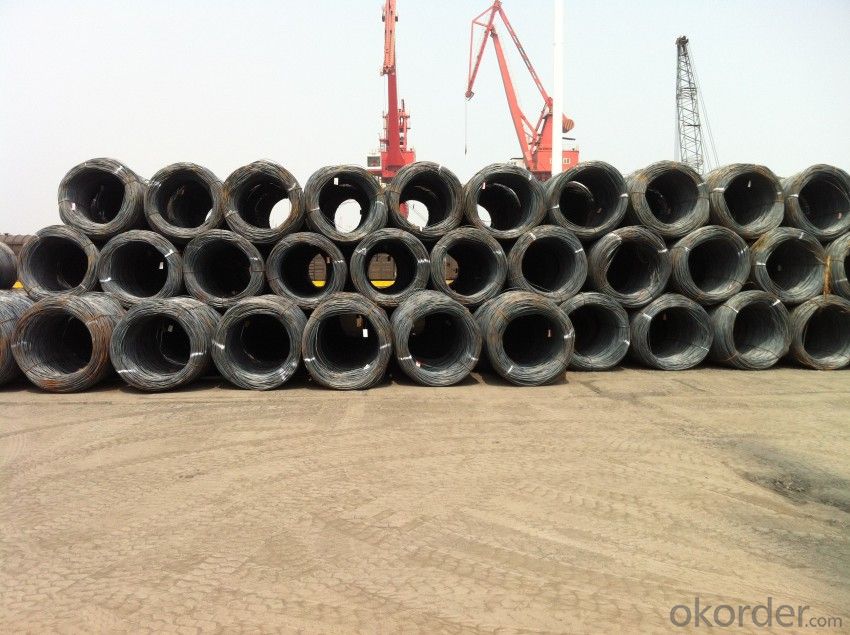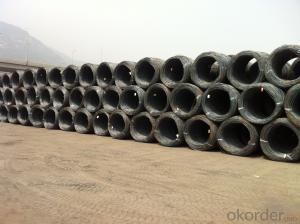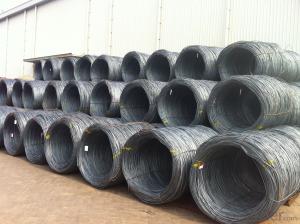Hot Rolled Steel Wire Rods with Grade ASTM SAE1008
- Loading Port:
- Tianjin
- Payment Terms:
- TT OR LC
- Min Order Qty:
- 25 m.t
- Supply Capability:
- 20000 m.t/month
OKorder Service Pledge
OKorder Financial Service
You Might Also Like
Item specifice
OKorder is offering Hot Rolled Carbon Steel Wire Rod 5.5mm with High Quality at great prices with worldwide shipping. Our supplier is a world-class manufacturer of steel, with our products utilized the world over. OKorder annually supplies products to European, North American and Asian markets. We provide quotations within 24 hours of receiving an inquiry and guarantee competitive prices.
Product Applications:
Hot Rolled Carbon Steel Wire Rod 5.5mm with High Quality is widely used in construction and manufacturing. Carbon steel wire rod is mainly used for reinforcement of reinforced concrete and welded structure or reprocessed (roberts , nail, etc.) materials, especially used to produce wire drawing, welding electrode, nails, spring, electronic, precise machinery parts and so on.
Product Advantages:
OKorder's Hot Rolled Carbon Steel Wire Rod 5.5mm with High Quality are durable, strong.packed and suitable for wire mesh,nail manufacture and construction
Main Product Features:
· Premium quality
· Prompt delivery & seaworthy packing (30 days after receiving deposit)
· Can be recycled and reused
· Mill test certification
· Professional Service
· Competitive pricing
Product Specifications:
Manufacture: Hot rolled
Grade: SAE1006 SAE1008 SAE1010 SAE1012 SAE1016 SAE1018
Certificates: ISO, SGS, BV, CIQ
Weight per Coil:2-2.05tons
Packaging: Export packing, packed by coil
Grade | Chemical Composition (%) | |||||
C | Mn | S | P | Si | B | |
SAE1006B | 0.03~O.07 | 0.32max | 0.045max | 0.040max | 0.30max | 0.0008min |
Mechanical properties | ||||||
Yield strength(N/mm2) | Tensile strength(N/mm2) | Elongation (%) | ||||
250-280 | 350-380 | ≥32 | ||||
Grade | Chemical Composition (%) | |||||
C | Mn | S | P | Si | B | |
SAE1008B | 0.10max | 0.3~0.50 | 0.050max | 0.040 max | 0.15max | 0.0008 min |
Mechanical properties | ||||||
Yield strength(N/mm2) | Tensile strength(N/mm2) | Elongation (%) | ||||
≥195 | 315-430 | ≥30 | ||||
FAQ:
Q1: Why buy Materials & Equipment from OKorder.com?
A1: All products offered byOKorder.com are carefully selected from China's most reliable manufacturing enterprises. Through its ISO certifications, OKorder.com adheres to the highest standards and a commitment to supply chain safety and customer satisfaction.
Q2: How do we guarantee the quality of our products?
A2: We have established an advanced quality management system which conducts strict quality tests at every step, from raw materials to the final product. At the same time, we provide extensive follow-up service assurances as required.
Q3: How many tons can be loaded into one 20ft container?
A3: Around 18—20tons,9-10 coils.
Image:


- Q:How is steel wire rod used in the manufacturing of wire for automotive seat frames?
- Steel wire rod is an essential material used in the manufacturing process of wire for automotive seat frames. The wire rod is initially produced through a series of steelmaking processes, including melting, refining, and casting. Once the steel wire rod is formed, it undergoes further processing, such as hot rolling or cold drawing, to achieve the desired shape and size for the wire. In the production of wire for automotive seat frames, the steel wire rod is typically fed into a wire drawing machine. This machine pulls the wire rod through a series of dies, which progressively reduce the diameter of the wire while elongating it. This process helps to improve the wire's strength, flexibility, and surface finish. The resulting wire is then used to construct the seat frames of automobiles. The wire is usually bent and shaped into the desired form using specialized machinery and techniques. It is commonly used to create the structural framework of the seat, providing strength and stability. The use of steel wire rod in the manufacturing of wire for automotive seat frames offers several advantages. Firstly, steel is a strong and durable material, ensuring that the seat frames can withstand the various stresses and forces encountered during use. Additionally, steel wire is highly flexible, allowing it to be easily shaped and formed into intricate designs required for seat frames. Moreover, steel wire has excellent corrosion resistance properties, ensuring that the seat frames remain in good condition over an extended period. Furthermore, steel wire rod is a cost-effective material choice for automotive seat frames. Steel is abundantly available and has relatively low production costs compared to other materials. This makes it an attractive option for manufacturers looking to produce seat frames at a reasonable price without compromising on quality or performance. In conclusion, steel wire rod plays a critical role in the manufacturing of wire for automotive seat frames. Its strength, flexibility, corrosion resistance, and cost-effectiveness make it an ideal material choice. By using steel wire rod, manufacturers can produce high-quality seat frames that meet the rigorous standards of the automotive industry.
- Q:How is the steel wire rod industry affected by fluctuations in raw material prices?
- The steel wire rod industry experiences significant effects due to fluctuations in raw material prices. Raw materials, including iron ore, coal, and scrap metal, play a crucial role in the production of steel wire rods. Any changes in the prices of these raw materials can directly influence the production costs for manufacturers of steel wire rods. When there is an increase in raw material prices, it directly raises the input costs for producing steel wire rods. This situation puts pressure on manufacturers to either absorb the higher costs, leading to reduced profit margins, or pass on the increased costs to customers in the form of higher prices. In either scenario, the competitiveness of steel wire rod manufacturers in the market can be impacted. On the contrary, when there is a decrease in raw material prices, it can provide some relief to steel wire rod manufacturers as it reduces their production costs. This enables manufacturers to offer lower prices or maintain their profit margins while remaining competitive in the market. Fluctuations in raw material prices also have an impact on the supply chain of the steel wire rod industry. Manufacturers depend on a steady supply of raw materials, and any disruptions or price volatility can affect their ability to procure sufficient quantities of raw materials. This can result in production delays, higher inventory costs, and overall productivity issues in the industry. Furthermore, fluctuations in raw material prices can also influence the profitability of steel wire rod manufacturers. If raw material prices increase significantly and manufacturers are unable to pass on the increased costs to customers, it can lead to reduced profitability and potentially financial losses. Conversely, when raw material prices decrease, manufacturers may experience improved profitability. In conclusion, fluctuations in raw material prices directly impact various aspects of the steel wire rod industry, including production costs, competitiveness, supply chain, and profitability. Consequently, industry players closely monitor and analyze trends in raw material prices to make informed decisions and mitigate the impacts of price fluctuations.
- Q:How are surface defects in steel wire rod repaired or rectified?
- Surface defects in steel wire rods can be repaired or rectified through various methods. One common approach is to remove the defects by grinding or polishing the affected area to remove any surface imperfections. Alternatively, the defective portion can be cut off entirely, resulting in a shorter rod. In more severe cases, heat treatment techniques might be employed to improve the overall quality of the wire rod. Ultimately, the specific repair method will depend on the nature and extent of the surface defect.
- Q:How is the quality of steel wire rod measured?
- The quality of steel wire rod is measured through a series of tests and evaluations to assess its mechanical properties, chemical composition, and overall performance. The key parameters used to determine the quality of steel wire rod include: 1. Tensile Strength: This test measures the maximum amount of stress a wire rod can withstand before breaking or experiencing deformation. It indicates the rod's ability to bear weight and resist tension. 2. Yield Strength: This test determines the level of stress at which the wire rod begins to deform permanently. It indicates the rod's ability to return to its original shape after being subjected to stress. 3. Elongation: This test measures the percentage increase in length of the wire rod before it breaks under tension. It provides insights into the rod's ductility and ability to elongate without losing its integrity. 4. Hardness: This test determines the resistance of the wire rod to indentation or scratching. It provides an indication of the rod's strength and durability. 5. Chemical Composition: The composition of the steel wire rod is analyzed to ensure it meets the required standards and specifications. It includes evaluating the levels of carbon, manganese, silicon, sulfur, phosphorus, and other alloying elements. 6. Surface Quality: The wire rod's surface is inspected visually and sometimes through microscopic analysis to detect any defects, such as cracks, scratches, or impurities. A smooth and clean surface is crucial for optimal performance. 7. Dimensional Accuracy: The wire rod's diameter and length are measured to ensure they meet the specified tolerances. Any deviations from the required dimensions can affect the rod's usability in various applications. 8. Microstructure Analysis: This examination involves detailed observation of the wire rod's internal structure using microscopy. It helps identify the presence of any abnormalities, such as grain size, inclusions, or segregation, that may impact its strength and performance. By conducting these tests and evaluations, manufacturers can ensure that the steel wire rod meets the required quality standards and is suitable for its intended applications, such as manufacturing wire products, reinforcing materials, or springs.
- Q:How is steel wire rod used in the manufacturing of wire forms?
- Steel wire rod is a crucial raw material in the manufacturing of wire forms. It is initially drawn through a series of dies to reduce its diameter and increase its strength. The resulting wire is then shaped into various forms, such as springs, clips, and hooks, through processes like bending, cutting, and welding. The high strength and durability of steel wire rod make it ideal for creating sturdy and reliable wire forms used in industries such as automotive, construction, and furniture.
- Q:How is steel wire rod used in the manufacturing of wire forms for marine equipment?
- Steel wire rod is used in the manufacturing of wire forms for marine equipment because of its high strength and corrosion resistance properties. It is commonly shaped and formed into various wire products such as cables, ropes, and springs, which are essential components in marine equipment like ships, offshore platforms, and fishing vessels. The steel wire rod provides the necessary strength and durability needed to withstand harsh marine environments and heavy loads, ensuring the safety and reliability of the equipment.
- Q:How is steel wire rod used in the manufacturing of wire rope clips?
- Steel wire rod is used as the primary material in the manufacturing of wire rope clips. It is formed into the desired shape and size, and then undergoes processes such as heat treatment and galvanization to enhance its strength and durability. The steel wire rod serves as the core component of wire rope clips, providing the necessary strength and reliability to securely fasten and clamp wire ropes together.
- Q:What are the standard specifications for steel wire rod?
- The steel wire rod's standard specifications differ depending on the industry and specific application. However, there are commonly followed general standards and specifications. The American Society for Testing and Materials (ASTM) standard is the most widely used standard for steel wire rod. The ASTM A510/A510M standard specifies the general requirements for wire rods and coarse round wire, carbon steel. It covers various aspects such as chemical composition, mechanical properties, dimensions, and tolerances. Regarding chemical composition, the standard sets maximum limits for carbon, manganese, phosphorus, and sulfur content. These limits ensure that the steel wire rod possesses the necessary strength, ductility, and other mechanical properties. The standard also specifies the mechanical properties of the steel wire rod, including minimum yield strength, tensile strength, and elongation. These properties determine the wire rod's ability to withstand applied forces and deformation without breaking or failing. Additionally, the standard outlines the dimensions and tolerances for the steel wire rod, including diameter, length, and straightness. It provides guidelines for acceptable deviations from the specified dimensions to ensure consistency and quality. Apart from the ASTM standard, specific industries may follow their own standards based on the intended application of the steel wire rod. These industry-specific standards may include additional requirements or properties relevant to the specific industry or application. In summary, the standard specifications for steel wire rod cover various factors such as chemical composition, mechanical properties, dimensions, and tolerances. These specifications guarantee that the steel wire rod meets the necessary quality and performance standards for its intended use.
- Q:How is steel wire rod used in the production of wire mesh for industrial filtration systems?
- Steel wire rod is used in the production of wire mesh for industrial filtration systems as it serves as the raw material for creating the mesh structure. The wire rod is first drawn and processed into various diameters and gauges to achieve the desired strength and flexibility for the wire mesh. These wires are then woven or welded together to form a mesh pattern, creating a sturdy and durable filtration system capable of withstanding high temperatures and pressures.
- Q:What are the different types of steel wire rod coatings available?
- There are several types of steel wire rod coatings available, including galvanized coating, zinc-aluminum coating, and epoxy coating.
1. Manufacturer Overview |
|
|---|---|
| Location | |
| Year Established | |
| Annual Output Value | |
| Main Markets | |
| Company Certifications | |
2. Manufacturer Certificates |
|
|---|---|
| a) Certification Name | |
| Range | |
| Reference | |
| Validity Period | |
3. Manufacturer Capability |
|
|---|---|
| a)Trade Capacity | |
| Nearest Port | |
| Export Percentage | |
| No.of Employees in Trade Department | |
| Language Spoken: | |
| b)Factory Information | |
| Factory Size: | |
| No. of Production Lines | |
| Contract Manufacturing | |
| Product Price Range | |
Send your message to us
Hot Rolled Steel Wire Rods with Grade ASTM SAE1008
- Loading Port:
- Tianjin
- Payment Terms:
- TT OR LC
- Min Order Qty:
- 25 m.t
- Supply Capability:
- 20000 m.t/month
OKorder Service Pledge
OKorder Financial Service
Similar products
New products
Hot products
Related keywords




























